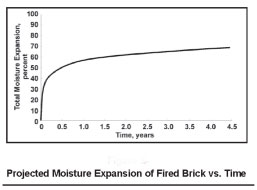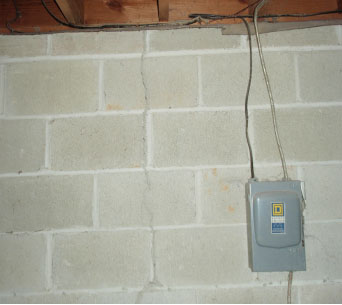 Cracks can form in masonry walls simply because of shrinkage and/or expansion/contraction of the walls. It is nearly impossible to prevent small cracks from forming in concrete masonry walls, as cracks occur naturally due to cement hydration shrinkage, which is a natural reduction in volume due to loss of water while curing/hardening. For example, a typical masonry wall that is 35 feet long will experience about ¼ inch of shrinkage from cement hydration. Clay masonry (brick) is manufactured in high temperature kilns so that the bricks initially are very dry, and subsequently expand over time due to long-term moisture absorption. Moreover, all masonry materials tend to “shrink and swell” throughout their lifetime due to seasonal changes in moisture content and surrounding temperatures. For example, clay masonry has a total expansion rate of about 0.09%, including long-term moisture absorption and seasonal expansion, meaning that a 25-feet-long brick wall may expand more than ¼ inch. These volume changes cause internal stresses and subsequent cracks. Cracks can begin as hairline-size, which may not be visible without magnification. Once cracks form, they generally continue to enlarge over time.
Cracks can form in masonry walls simply because of shrinkage and/or expansion/contraction of the walls. It is nearly impossible to prevent small cracks from forming in concrete masonry walls, as cracks occur naturally due to cement hydration shrinkage, which is a natural reduction in volume due to loss of water while curing/hardening. For example, a typical masonry wall that is 35 feet long will experience about ¼ inch of shrinkage from cement hydration. Clay masonry (brick) is manufactured in high temperature kilns so that the bricks initially are very dry, and subsequently expand over time due to long-term moisture absorption. Moreover, all masonry materials tend to “shrink and swell” throughout their lifetime due to seasonal changes in moisture content and surrounding temperatures. For example, clay masonry has a total expansion rate of about 0.09%, including long-term moisture absorption and seasonal expansion, meaning that a 25-feet-long brick wall may expand more than ¼ inch. These volume changes cause internal stresses and subsequent cracks. Cracks can begin as hairline-size, which may not be visible without magnification. Once cracks form, they generally continue to enlarge over time.
 Expansion or shrinkage cracks in masonry typically form in vertical or stair-step patterns. These crack formations are almost never structurally significant and do not require structural repairs. Even if cosmetically repaired by mortar-pointing, the cracks would probably re-occur seasonally unless a system of expansion-joints is constructed in key areas. A trained and experienced forensic engineer should be able to perform tests and measurements to determine whether the cracks are structurally significant or have simply formed from expansion or contraction movements.
Expansion or shrinkage cracks in masonry typically form in vertical or stair-step patterns. These crack formations are almost never structurally significant and do not require structural repairs. Even if cosmetically repaired by mortar-pointing, the cracks would probably re-occur seasonally unless a system of expansion-joints is constructed in key areas. A trained and experienced forensic engineer should be able to perform tests and measurements to determine whether the cracks are structurally significant or have simply formed from expansion or contraction movements.
 Vertical cracks often form in long concrete masonry walls simply from expansion/contraction movements. These cracks can become relatively large, but are not structurally significant. The cracks are most often seen in basement foundation walls, but commonly occur on concrete brick veneer exterior walls as well. Because of restraint provided by the footings or concrete-slab floors, these cracks are usually slightly larger at the top than at the bottom.
Vertical cracks often form in long concrete masonry walls simply from expansion/contraction movements. These cracks can become relatively large, but are not structurally significant. The cracks are most often seen in basement foundation walls, but commonly occur on concrete brick veneer exterior walls as well. Because of restraint provided by the footings or concrete-slab floors, these cracks are usually slightly larger at the top than at the bottom.
Vertical cracks are common at corners, offsets or setbacks of brick veneer walls. Perpendicular walls will expand in the direction of the corner, causing rotation and cracks near the corner. Cracks often appear at window and door openings as well. More movement tends to occur above or below window openings. Less movement occurs along the line of the windows because there is less masonry. This differential movement causes cracks to emanate from the corners of the opening in the brick veneer.



